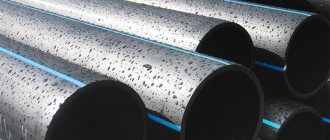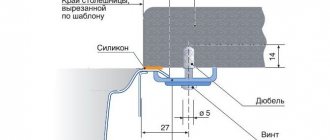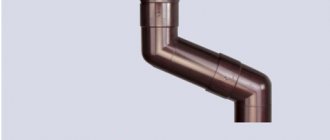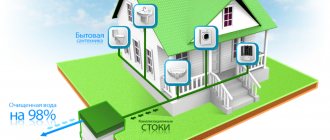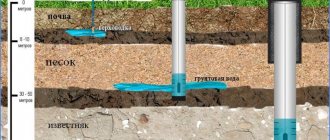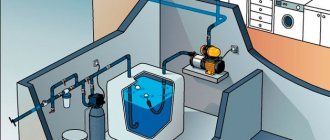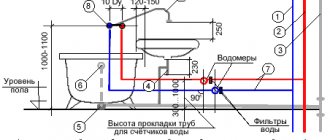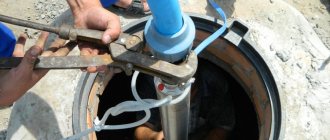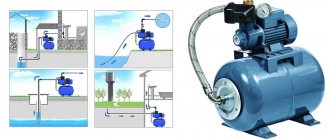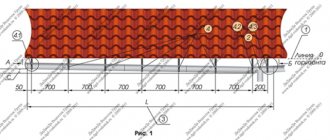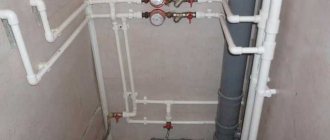- Services
- Repair of drainpipes, installation of drains
We provide services for repairing drainpipes and replacing roof drains.
This type of work is most in demand in the spring. After the snow melts, a preventive inspection of the external drainage system is performed. It is advisable to complete the repair of drainpipes before the onset of the rainy season. Installation of gutters is most often carried out in parallel with roof repairs.
The main task of the external drainage system is to effectively drain rain and melt water from the roof of the building. At the same time, even during heavy rainfall, water should not overflow over the edge of the gutter or funnel and fall onto the facade. When regularly wet, the facade quickly collapses, which entails unscheduled repair work.
At the design stage of an external drainage system, special attention should be paid to the correct selection of the diameter of the drainpipes. The cross-sectional area of the drainpipe should be taken at the rate of 1.5 sq.cm per 1 sq.m of roof area.
Drainage defects: types and factors of their formation
The drainage system of a house is exposed to all natural stresses. And this does not remain without consequences. But among the reasons that lead to repair of roof gutters, there are others. Let's consider each defect separately and outline the methods and methods of elimination.
Installation error
Unfortunately, many Internet portals are full of messages that installing a drainage system yourself is not a problem. Despite the apparent simplicity of the drainage design, it is actually a complex system. Firstly, it is gravity-flowing, which means there are certain requirements for the inclination of its horizontal part. Secondly, an important point is competently carried out fasteners, on which the strength of the entire structure depends.
As for the first position. The mistake many owners make when installing gutters themselves is that they install the system’s gutters at the wrong angle. Or they simply display it incorrectly. And the slope value should vary in the range of 3-7°. That is, the difference in the installation height of one end of the gutter and the opposite should be 3-7 m per 1 m of the length of the horizontal part.
How to determine the angle of inclination of the guttered part of a roof drainage system Source strbuild.ru
For example, if the length of the cornice, and accordingly the tray part of the drain, is 10 m, then the difference in the height of the above-installed end above the lower-installed one should be 3-7 cm. Sometimes home craftsmen do not succeed in this, which means that the water that gets into the trays will be either flow down gutters slowly, causing blockages, or too quickly, overflowing the sides.
How to fix this defect:
- First of all, you will have to disassemble the tray part of the drainage system completely.
- Then decide on the location of the upper end of the tray .
- Here they install, at a distance of 30 cm from the edge of the cornice along the overhang, a bracket to support the gutter .
- A strong thread is tied to the attached bracket .
- The thread is pulled horizontally, and a mark is placed .
- From the last one, a size from the range of 3-7 cm is lowered down. The same second extreme bracket is attached to this place.
- The thread is tied to it.
- Intermediate brackets are installed along a stretched twine in 60 cm increments .
- Gutters are already installed on them .
Scheme for replacing a defective grooved part with a new one Source tincraft.com.ua
Regarding fasteners. There are usually no problems with vertical drainpipes. They are secured using plastic clamps, which are attached to the walls of the house with self-tapping screws and plastic dowels. The main task of the work manufacturer is to strictly adhere to the clamp installation step, which varies between 1.8-2.0 m. Please note that if the length of the vertical drainage elements exceeds 10 m, then the clamp installation step is reduced to 1.5 m.
It is more difficult to attach the brackets under the grooved part. It all depends on what kind of structure is used to construct the roof. The easiest option for repairing a drainage system is when the brackets are attached to the front board. For example, if the mounting point were the rafter legs, or rather their upper horizontal ends, then the roofing material that covers the overhang would have to be lifted. If there were side ends, then the soffits would have to be disassembled.
How to attach the brackets of the grooved part of the drain to the frontal board Source krovlyakryshi.ru
And another mistake of incorrect installation. There is a strict requirement that the gutters be installed relative to the edge of the roofing material. The latter should be located relative to the trays within 1/3 of their width. In this way, the exact flow of water into the tray part is achieved.
Fixing such a defect is not easy. To do this, you will have to either pull the brackets outward or recess them inside the rafter system. If the latter were installed on the frontal board, then shims will have to be installed under them. If, on the contrary, you need to make the gap smaller, then there is only one way out - change the brackets to devices with a smaller protrusion.
Water must accurately fall into the drainage system trays Source sam-postroj.su
Calculation error
Sometimes a gutter system kit is bought by eye. That is, they take the average diameters of vertical pipes and horizontal trays. And this is the wrong approach. Because both parameters must be purchased in accordance with the area of the slopes of the roofing structure, from which water from precipitation will be collected. And the larger the area of the slope, the larger the diameters of the elements of the drainage structure should be. Here the dependency is:
| Roof slope area, m² | Vertical pipe diameter, m | Gutter diameter, m |
| 70 | 75 | 100 |
| 70-120 | 90 | 125 |
| 120-150 | 100 | 150 |
| 150-200 | 120 | 200 |
And one moment. Table values must be used if one vertical riser is installed on the slope. Usually it is sufficient if the length of the roof eaves does not exceed 24 m. If possible, it is better to install two pipe risers, the distance between which should not exceed 12 m.
One riser is enough if the length of the cornice does not exceed 24 m Source yellowpages.com
Mechanical damage
During long-term operation or if damaged by ice that formed during the freezing process of water, elements of the drainage system may crack or burst. Failed gutters, pipes, funnels and fittings cannot be restored. That is, repairing a drain on the roof of a private house develops into a complete replacement of these elements.
How to replace a gutter. Trays are usually simply laid on brackets and attached to them in various ways. So the first thing you need to do is understand the fastening system. And then try to loosen this fastening. After which the defective gutter is removed, and a new one, chosen exactly in size and color, is installed in its place.
The joints of the trays must be treated with silicone sealant to increase the tightness of the connecting areas. Check the installation for the slope of the horizontal part of the drain. Then the fastening is carried out.
In principle, the pipes of vertical risers must be replaced in the same way. There is no need to remove clamps from the walls. They simply open in the defective area, pipes are pulled out from the inside and replaced with new ones. Installation is carried out in reverse order.
Installation of a new pipe ↑
Vertical drainpipes are designed to drain atmospheric precipitation from receiving funnels and gutters. The greatest danger is posed by large volumes of water and accumulated debris. Also, in the absence of a heating system, there is a high probability of the formation of ice plugs, which not only prevent the drainage of liquid, but also significantly increase the load on the pipe walls.
The most common defect of this drainage element is the appearance of cracks due to strong mechanical stress. The procedure for replacing a pipe is similar to the same procedure for a gutter. The difference lies in the correct selection of diameter and model. In most cases, the connection of individual elements is carried out using socket joints. Therefore, when purchasing a new pipe, it is recommended to take a sample of the old one with you.
To perform a quality repair, it is recommended to remove the pipe, except for the upper elbow.
- Dismantling the outer arcs of the mounting clamps.
- Removing the drainpipe.
- Removing the damaged area. If the connection point is clogged or difficult to remove, you can use WD-40 (for galvanized models) or a lubricant (for plastic ones).
- Installation of a new pipe. Its size should match the old one.
After this, the entire structure is installed in its old place, the correct level of location and reliability of fastening must be checked.
Advice
To prevent the occurrence of ice jams, it is recommended to install heating cables.
They are installed on the inner surface of the pipe. To select a specific model, it is necessary to perform a preliminary power calculation. This way you can replace your gutters yourself with minimal financial outlay.
Video description
The video shows how a metal pipe riser for a drain that has simply rotted is repaired:
See also: Catalog of companies that specialize in roof repairs.
Sometimes there are small cracks that, if not repaired, can develop into large flaws. If the drain is metal, then you can try to paint over the crack with a thick layer of paint matched to the color of the drainage system. It is better to use so-called rubber paint for this.
If the drainage system is made of plastic, then the crack can be welded using two-component cold welding. Essentially, this is a special solution that is applied to the defect site. It fills the crack, preventing it from expanding and lengthening.
Mechanical damage also includes failure of fasteners. Easier with clamps.
- They need to be unfastened .
- Pull the pipe out.
- Remove the fastener by unscrewing the self-tapping screw from the dowel.
- Install the new one by screwing the screw back in.
It’s more difficult with brackets, especially those that are screwed to the rafters or sheathing. To do this, you will have to partially dismantle the roofing material. In any case, raise its edge at the eaves of the roof.
The drainage system is rotten and leaking Source in.pinterest.com
Storm sewer repair
After long-term use, parts of the stormwater system inevitably wear out and fail. This can lead to the following consequences:
- Subsidence and destruction of wells and collectors of the system;
- Washing out bricks, crushed stone and other large elements from structures;
- Destruction of asphalt pavement near wells and above underground sewers;
- The tilt of the well tray, after which the water begins to erode the walls of the building.
Restoration work must be carried out even if at least one of the above problems is detected.
To repair storm drains, you may need both simple devices and special machines:
- Digging mechanisms - for digging out heavily damaged pipes;
- Shovels, scrapers, brushes - for cleaning products;
- New pipes - in case of replacing channels or strengthening them;
- Cement or concrete mortar - for repairing open system concrete trays or wells;
- Components for embossing joints of products - for connecting pipes;
- Horizontal drilling tools;
- Winch or hoist - for pulling pipes underground;
- Blower - for cleaning sewerage before repairs.
In case of emergency situations, perform the following operations:
- Pump out the water from the inspection well and inspect it. In sewers, it is often necessary to replace old slabs with new ones, remove brickwork and install concrete rings instead, and plaster the internal surfaces of the building.
- Clean the internal cavity of the line from deposits.
- Using the inspection well, find out the extent of damage to the structure.
- If crushed stone is visible in the channel, dig out the pipe and replace the damaged section.
- To replace pipes in inconvenient places, such as under a road, use the horizontal drilling method using a pneumatic punch. It moves along the collector strictly along the axis using a winch. The device destroys old pipes and makes an opening of a larger diameter. New products are fed through a manhole or a well dug at a slight angle.
- Reinforce rusted and rotten areas through which water leaks with plastic bushings made from polymer pipes. They are pressed into place using jacks.
During repairs, it is often necessary to reconstruct storm sewers, which involves replacing metal pipes with plastic ones. It is recommended to leave only a small amount of metal parts in the system, for example, do not touch the pipe outlet after the water seal. Polymer products do not fail for 50 years.
External gutters are often made of galvanized steel, so they are also periodically replaced with similar products. The service life of galvanized parts is longer than steel ones, because they are located outside and are constantly ventilated.
- See also typical mistakes when insulating sewer systems
So that defects do not appear for a long time
What can be done to avoid repairing the drainage system in a country house, or at least delay this process. There is only one option - every autumn after the leaves fall, clean the trays and pipes from debris, fallen leaves and twigs.
This can be done with your hands, scrapers or a broom. Companies that offer drain repair and cleaning services usually use a hydraulic method, which involves using pressurized water by installing a pump and a water tank.
In order not to waste time and money on this, it is better to install a grid or mesh made of a polymer composition in the tray part. The photo below shows how easy this can be done.
Protective mesh inside the gutter
How to install a drainage system correctly to avoid mistakes
To avoid repairs to the roof drainage system, it is important to initially install the structure correctly. Here are the basic principles:
- Temperature recording in the construction region. For structures made of galvanized steel, installation can be carried out at temperatures from -10 degrees and above.
- The gutter should have a slight slope towards the drain funnel - from 2 mm per 1 meter of gutter.
- If there are several water inlets (funnels), they should be placed at different ends of the drainage trays, but at a distance of no more than 20 meters from each other.
- Brackets and hooks for fixing the gutter are placed at an equal distance. First, the first and last element are installed, the distance from the edge of the roof should be less than 20 cm. Then the remaining fasteners are installed in increments of 600-800 mm.
- Snow is one of the factors that can cause damage to the drainage system. To protect it, you need to install gutters below the expected projection of the roof slope, and also install snow guards.
- To fix galvanized gutters, seals and clamps are used. Cut elements to fit them to size using metal scissors. This will eliminate the risk of damage to the coating.
It is also necessary to maintain the distance of the fragments of the drainage system from the walls of the building. The pipes should be separated by 3-10 cm, the drain should be placed at a height of 15 cm from the blind area or 25 cm from the ground. Pipe fasteners are installed in 2-meter increments.
Repair of internal drainage
An internal drain is one part of vertically installed pipes that penetrate a private house from the roof to the basement. They try to hide the pipes in the walls, so the pipes rarely crack or burst, because the temperature is always positive.
Usually the funnel that is installed on the surface of a flat roof fails. It is simply replaced with a new one. But this is associated with a rather complex repair process affecting the roofing material of the roof. Because the coating, which is a bitumen-based roll roofing, must cover the funnel fields. That is, replacing the latter means opening a section of roofing material. This must be done carefully so as not to break the tightness of the coating.
It is impossible to repair the drainage system from the inside if the pipes are embedded in the walls. If they are carried out separately from the supporting structures, then the repair is carried out in exactly the same way as in the case of pipe risers of the external drainage system. That is, replacing failed ones with new ones. The pipes are assembled using the socket method, so dismantling the defective section and installing a new one is easy.
Replacing an internal drain on a flat roof
Features of storm sewer operation
The photo shows a clogged storm drain.
Storm drainage is designed to drain rainwater from the site. However, without constant maintenance, the system quickly becomes clogged with debris and ceases to perform its functions. Such troubles occur in all types of drainage systems, regardless of design.
Problems appear for the following reasons:
- A large amount of debris gets into the gutters during precipitation and with melt water, so most often they become clogged in the spring and during the heavy rainy season.
- Regular penetration of insects, small branches, sand, etc. into the pipes.
- Incorrect installation. The assembled system must comply with the requirements of SNiP 2.04.01-85. For example, pipes are laid with a slope of 2-7 mm/m towards the drain. If the slope is insufficient, the water flows slowly and leaves debris in the line. If the angle is too large, the liquid escapes without heavy dirt.
- Lots of sharp bends. Debris will accumulate around corners.
- Integration of storm sewer with public sewer system. Too many solids and fat get into such a system. They mix and, after hardening, create a very dense plug that water cannot wash away.
- Construction work on the site. Styrofoam, shavings, remnants of plaster and other debris that are impenetrable to water may remain in gutters, trays, and drains.
Clogged storm drains lead to large amounts of water appearing in the area, which has a bad effect on the environment:
- It can erode the foundation of a building, flood the basement, lead to waterlogging of the area, etc.
- The accumulated dirt on the roofing system creates additional stress on the fasteners, which may fail and destroy the structure.
- Water spilling over the edge of the gutter hits the walls and ceiling and causes dampness in the room.
- Debris accumulates on the roof, under which it is always damp.
The following methods are used to clean storm drains:
- Mechanical
is the simplest option for open and closed systems. Dirt is removed manually or using simple tools. - Hydrodynamic
- debris is removed by a stream of water. To work, you will need special equipment that supplies moisture under high pressure into the pipeline. - Thermal
- a stream of hot water or superheated steam is directed into a clogged drain. - Chemical
- for cleaning, special products are used that dissolve debris. They are harmful to the environment, so this method is used as a last resort.
When choosing a method for cleaning storm drains, you can use the table below:
| Cleaning method | Conditions of use | Features of use |
| Mechanical | For systems up to 100 m long, 50-500 mm in diameter | Cables with spiral ends |
| Hydrodynamic | For systems up to 50 m long, 20-300 mm in diameter | High-pressure pumping equipment with special nozzles |
| Chemical | For pipes up to 50 m long, 20-300 mm in diameter | Technical cleaning products, wastewater collection and filtration |
In practice, various methods are often combined to increase cleaning efficiency, for example, mechanical with hydraulic or chemical with hydraulic.
- Read more about how to make a storm drain
Gutter repair prices
Today, a large number of companies offer services for repairing gutters on the roofs of private houses with prices that depend on the volume of operations performed and the degree of defectiveness of elements of drainage systems. From several prices:
- dismantling 1 m of system length - within 400 rubles;
- installation of a new element – 300 rubles;
- replacement of brackets – 100 rubles/piece;
- replacement of clamps – 100 rubles/piece;
- replacement of funnels and drains – 100-150 rubles/piece.
What is the difference between major and current repairs
» The concepts of routine repairs and major repairs have entered the everyday life of residential property owners.
The appearance of buildings and structures, people’s awareness of the influence of each owner on the processes occurring in the housing and communal services sector depend on them; it is necessary to clearly distinguish these concepts, know their purpose and role provided by the legislator. A number of legislative acts adopted in the Russian Federation help to clarify the term “current repairs”.
These include the Decree of the State Construction Committee of the Russian Federation dated September 27, 2003 No. 170
“On approval of the Rules and Standards for the technical operation of the housing stock”
, Town Planning Code of the Russian Federation.
The definition of “routine repair” characterizes systematic work related to the correction of minor defects and malfunctions. The goal is to maintain the building’s engineering structures in working condition.
Activities include lists of work to replace or repair existing equipment, strengthening it in order to prevent further destruction. An example is strengthening a roof structure by adding rafters. Current repairs have the following features:
- systematicity. Only constant maintenance of the building and its engineering structures in working condition increases its service life.
- planning. The plan is drawn up several years in advance after inspecting the entire territory and taking inventory of the main structural elements;
Preventive measures are carried out by the campaign manager or contractor.
This type of work can be not only preventive, but also urgent and unforeseen. Its goal is to urgently eliminate a newly identified defect for the purpose of restoration.
Problems are discovered by the residents of the house personally or identified during ongoing repair work. A major overhaul has larger tasks than the current one. Implies restoration or complete replacement:
- Engineering systems.
- Communications.
- Building design elements.
The goal is to eliminate the wear and tear of the building that affects the functioning of the systems.
Karsts on the façade
Since cement is made from limestone, it means that this rock also contains the same alkali, calcium hydroxide. And when filtered with water, it also dissolves and is washed out of the mountain range, like from concrete or masonry. In geology this is called the karst process. Over millions of years, water leaches cavities more than 2000 meters deep. There is no drainage system in the mountains, so if you see limestone mountains, you can be sure there are caves.
But you have every opportunity to avoid them on your facade by carefully protecting it from the effects of water flows.
